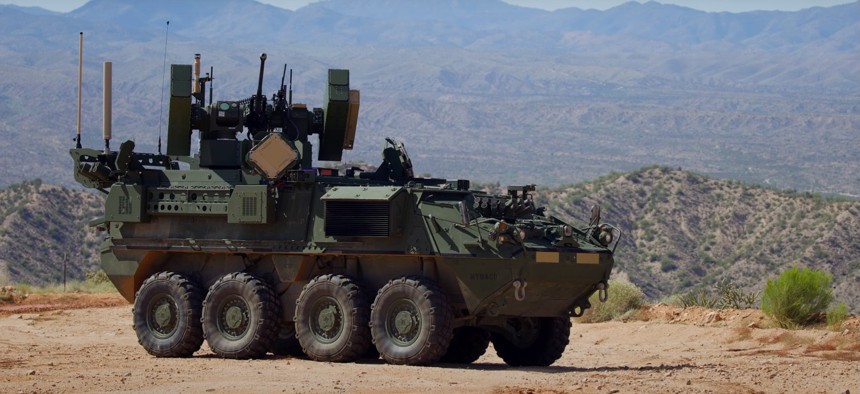Leonardo DRS CEO: Supply chains have ‘stabilized,’ but certain parts remain hard to get

Leonardo DRS' Single-Vehicle Counter-UAS Stryker prototype for the U.S. Army. Leonardo DRS via YouTube
In the meantime, the company is pushing to have its electric drive technology integrated on more ship classes.
The pandemic-worn supply chain has stabilized, but it’s still taking too long to get certain materials and parts to build weapons, according to the CEO of a top mid-tier Pentagon supplier.
Improvement is necessary, said Bill Lynn, chief executive of Leonardo DRS.
“I define improvement as ‘the lead times are shortening’ and we're not seeing that,” Lynn said in an interview this week. “What we're seeing is stability—the lead times aren't getting longer.”
Leonardo DRS, which makes parts and electronic systems for military submarines, armored vehicles, aircraft, and satellites, has taken steps to make sure it gets the supplies it needs, including placing orders earlier and stockpiling for future work.
“We think it'll start to get better probably next year, and incrementally over time,” Lynn said. “But we haven't seen it yet get better.”
His company finds itself competing for parts with automotive and consumer-electronics suppliers.
“People are spooked by what happened [during the pandemic], so people are buying up maybe more than they need,” Lynn said.
Leonardo DRS, a subsidiary of Italian aerospace and defense firm Leonardo, has grown in recent years and last year went public through a reverse merger with Israeli defense firm RADA.
“People have used [special purpose acquisition companies] and people have used IPOs,” Lynn said. “This was better than both, [because] it didn't have the risk and the discount of an IPO and it doesn't have the kind of the crazy financial structure of a SPAC.”
Now, the company is looking for ways to grow its existing businesses. Among the areas where Lynn sees growth as a supplier to the Virginia-class submarine. The U.S. Navy wants to increase production dramatically in the coming years.
“That's not just increasing the throughput of the [ship] yards; you have to increase the capability of all the companies that support the yards, which is us,” Lynn said. “It means increased workload for us, but it means you have to invest to get that workload, you have to work with the Navy and the yards as to what work are we going to pull in to make this doubling possible.”
Lynn touted the company’s work building the electric propulsion system for the Navy’s new Columbia-class submarine.
“The real focus for us at this point is how do we take this cutting-edge technology and move it to other ship classes,” he said.
The Navy’s future destroyer and next-generation attack submarine are candidates for electric propulsion technology, which makes vessels less detectable, Lynn said.
“There's some pretty strong incentives to go electric, particularly for submarines,” he said. “Not only is it cheaper and more efficient” but also quieter.
In addition, Leonardo DRS is now building counter-drone technology for the Army’s Stryker vehicles. Previously, the technology required two vehicles, but engineers were able to shrink it to fit on one. That means fewer people are needed to operate it and it’s more affordable, Lynn said.
The company is also looking for ways to increase its space work.
“We've always been a space component, payloads, but it's been a niche business for us, largely in the weather satellite arena,” Lynn said. “We're finding our capabilities are now in demand, not just with weather satellites…but we've been able to show some pretty strong innovation.”
He said the company has unique satellite imaging sensors that produce clearer pictures without needing to be cooled. The company has technology on the Space Development Agency’s Tranche 1 missile tracking satellites.
“We see potential that we can expand that space position we have,” Lynn said.
